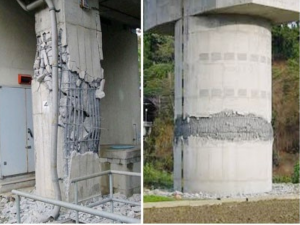PIPE MATERIALS (SEWER SYSTEMS)
- CHAPTER
CONSTRUCTION MATERIALS FOR SEWER SYSTEMS
SEWER SYSTEMS: Sewer pipes can be classified as metallic and non-metallic. The materials normally accepted for sewage system are the following: For metallic pipes:
- Cast iron
- Ductile iron
- Steel
- Others For non-metallic pipes:
- Ceramic
- Plain concrete
- Reinforced concrete
- Fiber cement
- Polyvinyl chloride (PVC)
- Polyethylene (PE)
- Thermoplastic
- High-density polyethylene
- Thermoset plastic
- Fiberglass (reinforced thermoset resin) RTR
- Reinforced plastic mortar RPM
-
Non-metallic pipes Ceramic pipes
- They are chemically inert,
- Through the years the natural clay has been suitably treated for their manufacture, achieving good quality, not only to resist the corrosive chemical attacks of domestic waters and but also for the structural aspects required in their installation,
- They have good resistance to abrasion,
- The clay pipes are smooth, with a low coefficient of friction, waterproof and little attack by acids,
- They must be controlled and verified due to their fragility, permeability through cracks, and the difficulty of executing their joints,
- Accessories are available in the illustrated shapes. Yees and tees must be used to join domestic sewers to public sewers and must be installed in the sewer when it is constructed,
- Open ends of unused connections can be closed with plugs or mortar until needed,
- Sections of a bell and spigot fittings for vitrified clay pipe: a) Yee, b) Double Yee, c) Tee, d) Reduction, e) Extension, f) Bifurcation, g) 1/8 Elbow, h) Saddle for Yee, i) Chair for Tee, j) ¼ elbow, k) Conveyor trap.
- The main most important characteristics of ceramic tubes are:
- Resistance to attack by organic compounds such as acids, salts, and bases except for hydrofluoric acid and its compounds.
- Resistance to the aggression of organic compounds and biological destructive agents.
- Low coefficient of thermal expansion (K = 5.10-6 m / ° C).
- Tightness less than 0.03 in 15 minutes
- Tightness less than 0.03 in 15 minutes
- Good mechanical resistance JOINTS IN CLAY TUBES • Plastic joints
- Joints previously prepared and fixed on the spigot and bell that are welded by simple pressure • Special joints
-
Concrete pipes
- The use of this type of pipe dates back to the construction of sewers in Rome, 800 years BC.
- In our continent, the first installed were in the US, around 1842.
- The tubes can be made of simple concrete or reinforced concrete.
- Concrete pipes are manufactured in metal molds, using concrete rich in cement dosage.
- There are various methods for the manufacture of these tubes, the best-known being: Vibro-compression, gyro-compression, centrifugation, pre-compression, and simple vibration.
- Preferably the first two systems are used for the manufacture of small diameter pipes instead of reinforced concrete pipes, the last three systems.
- CONCRETE PIPE MANUFACTURING Vibro-compression manufacturing
- Normally used in small pipe factories.
- The vibration is produced by placing and fixing the molds, vertically on a vibrating table, which determines their compaction.
- The degree of compaction of the mixture is quite acceptable, however, the manufacturing process is slow. Manufacture by gyro-compression
- Most used system for the manufacture of large quantities of concrete pipes. • Combined process of molding, compacting, and isolation.
- The degree of compaction of the concrete that is achieved by this method is higher than that obtained by vibrio compression, however, because a fairly dry mixture is used in this system, the consistency of the cement must be taken care of since it is a component very important of workability.
- The Abrahams Cone is used to determine the respective slump.
- Manufacture by centrifugation
- This manufacturing process is carried out in horizontal cylindrical molds, mounted on shafts. The molds receive a certain amount of concrete, very fluid, and that when it rotates for three to five minutes, at great speed (1200 rpm for small diameters.
- Pipes manufactured by this method can have reinforcement in the case of large diameters, on the other hand, for water supplies and sewerage in small diameters, such reinforcement is not required. CONCRETE PIPES There are two types of coupling that are the most commonly used in the union of concrete pipes:
- Spigot – bell joint
- Tongue and groove joint In both types, the joints can be rigid or elastic. use of elastic joints for various technical reasons that must be specified with priority.
- ADVANTAGES OF THE USE OF CONCRETE PIPES The main advantages are:
- Low roughness coefficient
- They can be manufactured for a wide range of resistances, varying only the thickness of the walls.
- They have the possibility of being manufactured in the same place of the works. MATERIALS FOR THE MANUFACTURE OF CONCRETE PIPES
- The type of cement, the aggregates and the dimensions of the pipes depend on the specifications adopted.
- Each standard determines the dimensions and resistance values obtained from the most unfavorable conditions. • Compression rings or washers should be used for sanitary sewer applications.
- Reinforced or reinforced concrete pipes the normal manufacturing procedures are:
- Centrifugation
- Compression twist
- Vibration The pipes must have reinforcement only when it comes to large diameters. In reinforced concrete pipes, the joint that is generally practiced is of the bell spike type, and it can be a rigid or elastic joint. Fiber cement pipes
- They are made from an intimate and homogeneous mixture of fibers and Portland or pozzolanic Portland cement, free of organic matter, with or without the addition of silica and water.
- Its use in sewerage networks is justified when high flexibility and joint impermeability demands are made.
- They are produced up to 90 cm, with spike and ball joints.
- For the joints, special rubber rings or pieces are used or, where appropriate, a tarred rope is placed in 1/3 of the joint, plastic mastic in the other third and in the final third a cement mortar is placed in proportion 1 cement for 2 sand
- Polyvinyl chloride (PVC) pipes Sewer System
- Great acceptance for sewer networks, only in small diameters of 6” and 8” since the cost is very high for larger diameters, thus producing very significant economic differences.
- PVC pipes are manufactured by extrusion.
- Pure PVC is supplied to processing industries in the form of a white powder.
- CHARACTERISTICS OF PVC TUBES
- They are light
- Inert to aggressive waters and corrosion of the earth
- There is no danger of obstruction in the tubes as a result of the formation of residues and oxides. Consequently, we can say that the useful section of the tubes remains practically unchanged.
- The inner surface of the tubes can be considered as “hydraulically smooth”.
- Rodents and termites do not attack rigid PVC pipes.
- Excellent behavior to momentary overpressures, such as water hammers.
- Better behavior than traditional tubes under the effects of frost.
- Inert to the effects of stray currents and telluric currents.
- They do not favor the development of algae or fungi according to long-term tests (5 years) JOINTS IN PVC PIPE There are two types of joints:
- Welded joint
- Elastic joint The type of joint recommended to absorb expansion effects is naturally the elastic joint. Joining can also be done by gluing, although this system is only suitable for small diameters.
- Polyethylene (PE) and polypropylene (PP) pipes Traditional PE and PPE pipes are manufactured in a similar way to PVC, by extrusion, although the molecular configuration of both is quite different. Polyethylene can be low density (less than 0.93 g / cm3) or high density (greater than 0.94 g / cm3). When laying the pipes, the stresses produced by expansion and retraction must be taken into account during the installation. Its use is recommended especially for submarine launches since they resist the attack of microorganisms that can cause perforations in the pipeline. JOINTS IN POLYETHYLENE AND POLYPROPYLENE PIPES The joining methods practicable in our environment are:
- By rubber gasket (optimal to counteract expansion and contraction)
- By putty The first case, the union is similar to the joint that is practiced in pipes made of PVC. In the second case, the joint is made by applying special plastic putties that fill the space between the pipes.
- Fiberglass tubes They are tubes of greater resistance and exist of greater diameters. Other types of plastic pipes for sanitation
- From a certain diameter, their manufacture becomes more expensive, slowing down the development of this type of material.
- New types of pipes have been developed capable of meeting all the requirements required by the user, with lower costs. For example:
- Helical
- Corrugated, single, or double layer
- Openwork profile
- Foamed
- Tests on the pipes the manufacturers of the pipes must guarantee the quality of the pipes, before they are marketed, by carrying out the following tests:
- Resistance test
- Absorption test
- Hydrostatic test Batches are considered to obtain the samples 300 tubes maximum and is shown as follows: 3% of the batch is verified dimensions. 1% is subjected to the resistance test, of its fragments the absorption test is carried out and another 1% is subjected to the hydrostatic test. RESISTANCE TESTS For simple tubes, the load is applied at a rate of 3000 kg per minute, the test is concluded when the tube presents cracks that go through the entire thickness. Resistance is measured by dividing the load by the net length of the tube.





